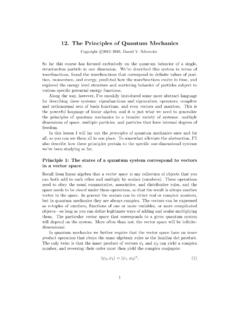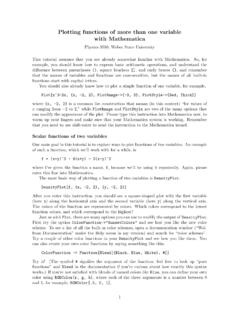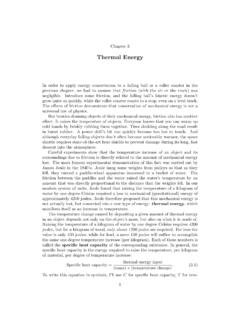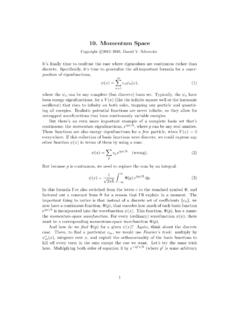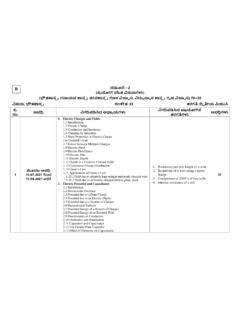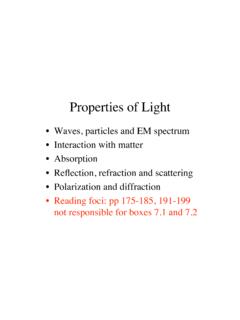Transcription of The Focal Length of Lenses
1 Focallengthoflenses1 TheFocalLengthofLensesOverview:In this experiment you determine and test the Focal Length of a thinlens. First you will use the lens characteristics to calculate its focallength, and then you will focus an image with the lens to physicallymeasure the same Focal principles:Lens maker s equationFocal lengthReal imagesEquipment needed:SpherometerFlat glass plateTraveling microscopeLarge double-convex lensOptical benchLight sourceSmall 75 mm Focal Length double-convex lensSmall 150 mm Focal Length double-convex lensViewing screenTwo component holders1.
2 The Lens Maker s EquationA lens uses its refractive properties to bend light. Lenses which are properlyconstructed direct light in a very orderly fashion, allowing images to be cre-ated. The Focal Length of a lens can be either positive or negative. Lenseswith positive Focal lengths are calledconverging lensesbecause they causeparallel light rays to come together at thefocal pointof the lens. Converginglenses can form a real image. Lenses with negative Focal lengths are calleddiverging lensesbecause they cause parallel light rays to diverge from thefocal pointof the lens.
3 Diverging Lenses cannot form a real image. Con-verging Lenses are thicker at the center than at the edges ( convex ), whilediverging Lenses are thinner at the center than at the edges ( concave ).Focallengthoflenses2 The Focal Length of a thin lens depends on theradius of curvature,R,ofeach surface of the lens, and theindex of refraction ,n, of the lens maker s equationfor the Focal Length ,f, of a lens is11f=(n 1)(1R1+1R2).(1)Because the surface of a lens may be either convex or concave, there aresignconventionsthat must be used with the radii in this : Sign conventions for equation 1 If one side of a lens isconvex( : if the glass bows outward), thenthe radius of curvatureRfor that side ispositive.
4 If one side of a lens isconcave(if the glass bows inward), then theradius of curvatureRfor that side Focal Length of a lens is the same on either side, and does not dependon which direction the light travels through the though you are able to utilize the lens maker s equation, it willdo you no good unless you know the radii of curvature for a lens and itsindex of refraction . The following explanations and procedures will helpyou determine this important InstructionsUsing a Spherometer to Measure the Radius of CurvatureThe radius of curvature,R, of the surface of a lens may be measured usinga device called aspherometer.
5 The spherometer is actually a small tripodconsisting of three equally spaced legs that form an equilateral three legs will always lie in a flat plane. A central screw is used tomeasure the distance between this plane and a given point, say at the topof a lens. This distance is called the sagittal distance,dsag, and is measuredusing the scale (in millimeters) on the use the spherometer, first place it on a flat piece of glass and turnthe central screw until it and all three legs are resting level on the surfaceof the glass.
6 Now put the spherometer on the surface of the lens, with the1 This version of the lens maker s equation is different than what you might have inyour text. Unfortunately, different texts will also use different sign (b)L(a){Figure 1: (a) The top view of a spherometer. (b)Speherometr on a convexlens. The figure shows the definition of L, and sagittal distance at the lens center. Turn the screw until it and the three legs are alltouching the surface of the lens at the same time. The distance the screwhad to be moved to do this is the sagittal distance.}
7 (Note: This can be atricky measurement to make with the spherometer. Be sure to be aware ofhow many times you have turned the dial on the spherometer as you adjustthe central screw!)Once the sagittal distance,dsag, has been measured, the radius of cur-vature,R, of the lens may be calculated usingR=L26dsag+dsag2,(2)whereLis the average distance between the three legs of the this brief background, you should be able to measure and recordthe requested information of Table 1 for the large, double convex lens. Foreach leg distance, you will be measuring a side of the triangle formed by thespherometer s three legs.
8 The spherometer s zero reading is the measurethat the spherometer reads when the three legs and the central screw allrest on a flat plane of glass. (This value will need to be subtracted fromFocallengthoflenses4any subsequent measurement you make with the spherometer.) You shouldhave one lens with two sides, each giving you a spherometer measurement,sagittal distance, and radius of curvature. (See Table 1.)Using a Traveling Microscope to Measure the Index of Re-fractionThe index of refraction of the lens material can be found by using atravelingmicroscope, which measures the change in the position of an image causedby refraction .
9 First, consider Figure 2, which shows rays light leaving apointAon a flat 2: Light rays leaving pointAwith no lensIn Figure 3, a flat glass plate of thicknessdhas been placed on top of the light at the upper surface of the glass plate causes thelight rays toappearto be coming from pointB, which is located a distancehbelow the top surface of the plate. Note thath<d, so the pointAappearscloser when viewed through the glass plate. The relationship betweend,h,and the index of refraction ,n, of the glass isn=dh.
10 (3)To measure the index of refraction of the lens material, the center of thelens is placed on top of pointA, as shown in Figure the thickness of the lens bed. As before, the pointAappears closerwhen viewed through the lens because the light rays appear to be comingFocallengthoflenses5 ABhdFigure 3: With a glass plate, light rays appear to leave pointBCABhdFigure 4: With a lens, light rays appear to leave pointBfrom pointB. Equation 3, which is valid only if the upper surface of theglass is flat, must be modified slightly for the curved upper surface of a lens.
